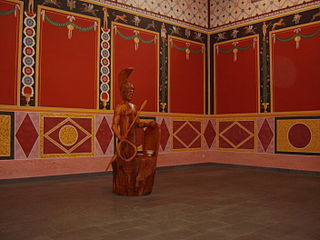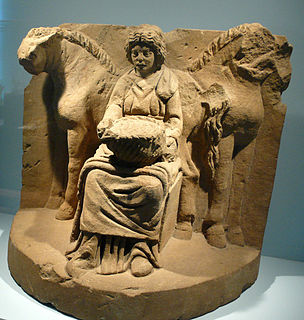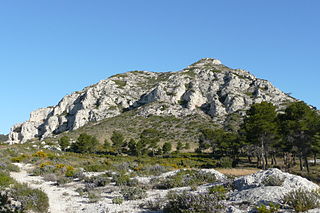Belenus is a sun god from Celtic mythology and, in the 3rd century, the patron deity of the Italian city of Aquileia. Called the "Fair Shining One", he was one of the most ancient and most-widely worshiped Celtic deities and is associated with the ancient fire festival and modern Sabbat Beltane. He was associated with the horse and also the wheel. Perhaps like Apollo, with whom he became identified in the Augustan History, Belenos was thought to ride the sun across the sky in a horse-drawn chariot.
In Lusitanian and Celtic polytheism, Borvo was the Celtic God of Minerals and healing deity associated with bubbling spring water.
In Celtic mythology, Condatis was a deity worshipped primarily in northern Britain but also in Gaul. He was associated with the confluences of rivers, in particular the River Wear which runs its course largely within County Durham. Condatis is known from several inscriptions in Britain and a single inscription found at Alonnes, Sarthe, France. In each case he is equated with the Roman god Mars.

In the Celtic polytheism of classical antiquity, Grannus was a deity associated with spas, healing thermal and mineral springs, and the sun. He was regularly identified with Apollo as Apollo Grannus. He was frequently worshipped in conjunction with Sirona, and sometimes with Mars and other deities.
In Gallo-Roman religion, Luxovios, Latinized as Luxovius was the god of the waters of Luxeuil, worshipped in Gaul. He was a consort of Bricta. The thermal spring sanctuary at Luxeuil produced evidence of the worship of other deities, including the sky-horseman who bears a solar wheel, and Sirona, another deity associated with healing springs.
Deus Nemausus is often said to have been the Celtic patron god of Nemausus (Nîmes). The god does not seem to have been worshipped outside this locality. The city certainly derives its name from Nemausus, which was perhaps the sacred wood in which the Celtic tribe of the Volcae Arecomici held their assemblies, or was perhaps the local Celtic spirit guardian of the spring that originally provided all water for the settlement, as many modern sources suggest. Or perhaps Stephanus of Byzantium was correct in stating in his geographical dictionary that Nemausos, the city of Gaul, took its name from the Heracleid Nemausios.

Nodens is a Celtic deity associated with healing, the sea, hunting and dogs. He was worshipped in ancient Britain, most notably in a temple complex at Lydney Park in Gloucestershire, and possibly also in Gaul. He is equated with the Roman gods Mars, Neptune and Silvanus, and his name is cognate with that of the Irish mythological figure Nuada and the Welsh Nudd.

The Glan is a river in Carinthia, Austria, a right tributary of the Gurk. It is 64.3 km long.
Veteris was a Celtic god attested from many inscriptions in Roman Britain. The dedicants were usually private individuals and were exclusively male. During the 3rd Century AD the cult was particularly popular among the ranks of the Roman army.

The Gallaeci, Callaeci or Callaici were a large Celtic tribal federation who inhabited Gallaecia, the north-western corner of Iberia, a region roughly corresponding to what is now northern Portugal, Galicia, western Asturias and western Castile and León in Spain, before and during the Roman period. They spoke a Q-Celtic language related to Northeastern Hispano-Celtic, usually called Gallaic, Gallaecian, or Northwestern Hispano-Celtic.
The Salyes or Salluvii in ancient geography, were a Gallic confederation that occupied the plain of the Druentia (Durance) in southern Gaul between the Rhône River and the Alps. They are said to have been the first transalpine people subdued by the Romans.

Lenus was a Celtic healing god worshipped mainly in eastern Gaul, where he was almost always identified with the Roman god Mars. He was an important god of the Treveri tribe, who had large sanctuaries at medicinal springs at Trier and the Martberg by Pommern in what is now Germany. Two dedications to him are also known from southwestern Britain. Edith Wightman characterizes him as “one of the best examples of a Teutates, or god of the people, equated with Mars—protector of the tribe in battle, but also [...] bestower of health and general good fortune” (p. 211). His sanctuary ‘Am Irminenwingert’ at Trier had a large temple, baths, smaller shrines and a theatre; that on the Martberg also included a large variety of buildings, probably including rooms for health-seeking pilgrims to stay. Despite his associations with healing, Lenus Mars is depicted classically as a warrior with Corinthian helmet in a bronze statuette from the Martberg.
Moritasgus is a Celtic epithet for a healing god found in four inscriptions at Alesia. In two inscriptions, he is identified with the Greco-Roman god Apollo. His consort was the goddess Damona.
Mars Iovantucarus was a Celtic god who was associated with the Treveran healer-god Lenus Mars at his sanctuary at Trier. The name reflects the deity's function as a protector of youth, and the temple was visited by pilgrims who often brought with them images of children, often depicting as holding pet birds as offerings to the god. At Tholey, also in Treveran territory, ‘Iovantucarus’ was also used as an epithet of Mercury.
According to classical sources, the ancient Celts were animists. They honoured the forces of nature, saw the world as inhabited by many spirits, and saw the Divine manifesting in aspects of the natural world.

The gods and goddesses of the pre-Christian Celtic peoples are known from a variety of sources, including ancient places of worship, statues, engravings, cult objects and place or personal names. The ancient Celts appear to have had a pantheon of deities comparable to others in Indo-European religion, each linked to aspects of life and the natural world. By a process of synthesism, after the Roman conquest of Celtic areas, these became associated with their Roman equivalent, and their worship continued until Christianization. Ancient Celtic art produced few images of deities, and these are hard to identify, lacking inscriptions, but in the post-conquest period many more images were made, some with inscriptions naming the deity. Most of the specific information we have therefore comes from Latin writers and the archaeology of the post-conquest period. More tentatively, links can be made between ancient Celtic deities and figures in early medieval Irish and Welsh literature, although all this was produced well after Christianization.

In the Roman Empire, Fortuna Redux was a form of the goddess Fortuna who oversaw a return, as from a long or perilous journey. Her attributes were Fortuna's typical cornucopia, with her specific function represented by a rudder or steering oar sometimes in conjunction with a globe.











